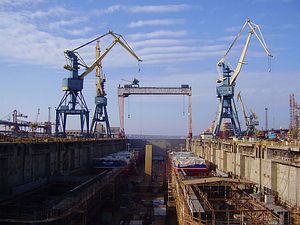One of the important subtexts in the clash between Russia and the Ukrainian government in Kiev has been the importance to Moscow of the significant and well-developed Ukrainian military-industrial complex, located primarily in eastern and southern Ukraine. According to SIPRI data, Ukraine was the world’s eighth largest arms exporter between 2009 and 2013, and Ukraine’s military-industrial complex is clearly one reason Moscow does not want to let go of the country.
It is also one of the most important reasons why Beijing cannot support Moscow in its bid to expand its influence in Ukraine, which led to China choosing to abstain from a UN Security Council draft resolution condemning Russia’s annexation of Crimea. China needs Ukrainian expertise in aircraft and helicopter engines, shipbuilding, landing craft, missile/space technology, and other areas. A Russian takeover would make Beijing even more beholden to Moscow for its defense needs. China has more at stake in the outcome of the Ukraine-Russia imbroglio than meets the eye.
What are the more important aspects of the Ukrainian MIC? For starters, Ukraine makes the Antonov AN225 (the world’s largest airplane), medium-size transport planes, gliders, and regional jets at a facility near Kiev. Motor-Sich, based in southeastern Ukraine’s Zaporizhia, is a leading producer of aircraft and helicopter engines, and in fact nearly all of Russia’s military helicopters are powered by Motor-Sich engines. Located in Dnepropetrovsk (also in southeastern Ukraine), Ukraine has an excellent space rocket and missile design and production industry, which produced rockets for the Soviet space program, and today produces/services Russia’s primary intercontinental ballistic missile, the SS18, as well as parts for Russia’s famous Soyuz rockets.
Along its Black Sea coast, Ukraine boasts an impressive shipbuilding industry, which produced the Varyag, which China purchased and retrofitted into the Liaoning, China’s first aircraft carrier, and according to Russian Vladimir Voronov, of the 54 surface warships acquisitions the Russian navy has currently planned, 31 would have Ukrainian engines in them. Ukraine also has an important armored vehicle-producing facility in Kharkiv, maker of the BTR-4 armored personnel carrier and the T84 main battle tank (a tank competitive with and having a more powerful engine than Russia’s primary main battle tank, the T-90, according to experts). The country also produces air-to-air missiles for fighter jets, and scores of parts and services for military applications, including some for Russia’s top-of-the-line fifth-generation jet fighter, the Su50 PAK/FA.
What are the implications of this for China? Most importantly, China has been behind the curve in military technology when compared to Russian, European and American competitors. Maintaining access to the Ukrainian arms market and its expertise is thus important to the Chinese arms industry, given its attractive offerings that are often priced more competitively than comparable Russian products. Moreover Ukraine does not appear to be bothered as much as Russia is by China’s tendency to buy military hardware abroad, then reverse engineer and manufacture copies at home. That issue has caused considerable tension between Russia and China, most notably in China’s purchase of the Su27 fighter aircraft from Russia, which Russia says China copied in its entirety when it produced its own J-11B fighter, leading to Russia ceasing coproduction agreements with China, and making Moscow very reluctant to sell China its newer technologies. However, Ukraine has sold China one Russian Su33 prototype which China used as the basis for its own J15 navy aircraft, and it also sells jet engines and helicopter engines, which China sorely needs.
Ukraine has also been a source of advanced air-to-air, surface-to-air, and cruise missiles for Beijing, as well as the Zubr landing craft (produced in Crimea and useful for potential operations against Taiwan, for example), the Varyag, and the Xue Long (or Snow Dragon, China’s only ice-breaker, in the news recently as it participated in the rescue of a trapped Russian ice breaker off Antarctica).
Changes in Ukraine’s status could spell trouble for China’s defense procurement and development in a number of ways. If Ukraine were to remain whole (sans Crimea) and join the EU, it might have to give up its military trade with China, because (as the U.S. does) the EU maintains post-Tiananmen sanctions against China. On the other hand, if Ukraine (or eastern Ukraine) is brought under Russian control, some or all of Ukraine’s arms deals (especially those that undermine Russia’s position in arms trade) may be halted, dialed down, or at least become subject to the ups and downs that have marked Sino-Russian arms trade in recent years.
The recent changes in Ukraine threaten China’s significant arms trade with Ukraine and can only further complicate China’s military modernization plans. Consequently, China has much at stake in the outcome of events in Ukraine.
Gregory J. Moore is an associate professor of International Relations at Zhejiang University in Hangzhou, China, where he teaches graduate and undergraduate courses in international relations.

































